Mucoadhesive and Antimicrobial Allantoin/β Cyclodextrins-Loaded Carbopol Gels as Scaffolds for Regenerative Medicine
Abstract
:1. Introduction
2. Materials and Methods
2.1. Materials
2.2. Preparation of the Mucoadhesive Gels
2.3. Methods
2.3.1. In Vitro Degradability of the Gels
2.3.2. Cell Culture and MTS Assay
3. Results and Discussion
3.1. Structural Characterization by FT-IR Analysis
3.2. Structural Characterization by 1H NMR Analysis
3.3. Contact Angle Analysis
3.4. Dynamic Vapor Sorption Analysis
3.5. Mechanical Tests
3.6. In Vitro Degradability of the Gels
3.7. Cell Culture Tests
3.8. Bioadhesion and Mucoadhesion Tests
3.9. Antimicrobial Susceptibility Tests
4. Conclusions
Supplementary Materials
Author Contributions
Funding
Institutional Review Board Statement
Informed Consent Statement
Data Availability Statement
Acknowledgments
Conflicts of Interest
References
- Rossi, F.; Santoro, M.; Casalini, T.; Veglianese, P.; Masi, M.; Perale, G. Characterization and Degradation Behavior of Agar–Carbomer Based Hydrogels for Drug Delivery Applications: Solute Effect. Int. J. Mol. Sci. 2011, 12, 3394–3408. [Google Scholar] [CrossRef] [PubMed] [Green Version]
- Feng, Q.; Li, D.; Li, Q.; Cao, X.; Dong, H. Microgel assembly: Fabrication, characteristics and application in tissue engineering and regenerative medicine. Bioact. Mater. 2022, 9, 105–119. [Google Scholar] [CrossRef] [PubMed]
- Hayati, F.; Ghamsari, S.M.; Tavassoli, A.; Azizzadeh, M. Carbomer 940 Hydrogel Enhances Capillary Blood Flow and Tissue Viability in a Skin Burn Wound. IJVS 2016, 11, 29–36. [Google Scholar]
- Huang, L.; Wang, J.; Huang, S.; Siaw-Debrah, F.; Nyanzu, M.; Zhuge, Q. Polyacrylic Acid-Coated Nanoparticles Loaded with Recombinant Tissue Plasminogen Activator for the Treatment of Mice with Ischemic Stroke. Biochem. Biophys. Res. Commun. 2019, 516, 565–570. [Google Scholar] [CrossRef]
- Larsson, M.; Bergstrand, A.; Mesiah, L.; Van Vooren, C.; Larsson, A. Nanocomposites of Polyacrylic Acid Nanogels and Biodegradable Polyhydroxybutyrate for Bone Regeneration and Drug Delivery. J. Nanomater. 2014, 2014, 371307. [Google Scholar] [CrossRef]
- Baruffaldi, D.; Pirri, C.F.; Frascella, F. 3D Bioprinting of Cell-Laden Carbopol Bioinks. Bioprinting 2021, 22, e00135. [Google Scholar] [CrossRef]
- Ning, L.; Mehta, R.; Cao, C.; Theus, A.; Tomov, M.; Zhu, N.; Weeks, E.R.; Bauser-Heaton, H.; Serpooshan, V. Embedded 3D Bioprinting of Gelatin Methacryloyl-Based Constructs with Highly Tunable Structural Fidelity. ACS Appl. Mater. Interfaces 2020, 12, 44563–44577. [Google Scholar] [CrossRef]
- Zhang, J.; Hu, J.; Chen, B.; Zhao, T.; Gu, Z. Superabsorbent Poly(Acrylic acid) and Antioxidant Poly(Ester amide) Hybrid Hydrogel for Enhanced Wound Healing. Regen. Biomater. 2021, 8, rbaa059. [Google Scholar] [CrossRef]
- Grip, J.; Engstad, R.E.; Skjæveland, I.; Škalko-Basnet, N.; Holsæter, A.M. Sprayable Carbopol Hydrogel with Soluble beta-1,3/1,6-Glucan as an Active Ingredient for Wound Healing–Development and in-vivo evaluation. Eur. J. Pharm. Sci. 2017, 107, 24–31. [Google Scholar] [CrossRef] [Green Version]
- Aswathy, S.H.; Narendrakumar, U.; Manjubala, I. Commercial Hydrogels for Biomedical Applications. Heliyon 2020, 6, e03719. [Google Scholar] [CrossRef]
- de Vries, M.E.; Bodde, H.E.; Busscher, H.J.; Junginger, H.E. Hydrogels for Buccal Drug Delivery: Properties Relevant for Muco-adhesion. J. Biomed. Mater. Res. 1988, 22, 1023–1032. [Google Scholar] [CrossRef]
- Sharpe, L.A.; Daily, A.M.; Horava, S.D.; Peppas, N.A. Therapeutic Applications of Hydrogels in Oral Drug Delivery. Expert Opin. Drug Deliv. 2014, 11, 901–915. [Google Scholar] [CrossRef] [PubMed] [Green Version]
- Laffleur, F. Mucoadhesive Polymers for Buccal Drug Delivery. Drug Dev. Ind. Pharm. 2014, 40, 591–598. [Google Scholar] [CrossRef] [PubMed]
- Salamat-Miller, N.; Chittchang, M.; Johnston, T.P. The Use of Mucoadhesive Polymers in Buccal Drug Delivery. Adv. Drug Deliv. Rev. 2005, 57, 1666–1691. [Google Scholar] [CrossRef] [PubMed]
- Anil, A.; Sudheer, P. Mucoadhesive Polymers: A Review. J. Pharm. Res. 2018, 17, 47–55. [Google Scholar]
- Shieh, W.J.; Hedges, A.R. Properties and Applications of Cyclodextrins. J. Macromol. Sci.–Pure Appl. Chem. 1996, A33, 673–683. [Google Scholar] [CrossRef]
- Tiwari, G.; Tiwari, R.; Awani, R. Cyclodextrins in Delivery Systems: Applications. J. Pharm. Bioall. Sci. 2010, 2, 72–79. [Google Scholar] [CrossRef]
- Muankaew, C.; Loftsson, T. Cyclodextrin-Based Formulations. A Non-Invasive Platform for Targeted Drug Delivery. Basic Clin. Pharmacol. Toxicol. 2018, 122, 46–55. [Google Scholar] [CrossRef] [Green Version]
- Igile, G.O.; Essiet, G.; Uboh, F.; Edet, E. Rapid Method for the Identification and Quantification of Allantoin in Body Creams and Lotions for Regulatory Activities. Int. J. Curr. Microbiol. Appl. Sci. 2014, 3, 552–557. [Google Scholar]
- Madrazo-Jimenez, M.; Rodriguez-Cabalero, A.; Serrera-Figallo, M.-A.; Garrido-Serrano, R.; Gutierez-Corrales, A.; Gutierez-Perez, J.-L.; Torres-Lagares, D. The Effects of a Topical Gel Containing Chitosan, 0.2% Chlorhexidine, Allantoin and Despanthenolon the Wound Healing Process Subsequent to Impacted Lower Third Molar Extraction. Med. Oral Patol. Oral Cir. Bucal 2016, 21, e696–e702. [Google Scholar]
- Pimentel, G.C.; Sederholm, C.H. Correlation of Infrared Stretching Frequencies and Hydrogen Bond Distances in Crystals. J. Chem. Phys. 1956, 24, 639–641. [Google Scholar] [CrossRef]
- Struszczyk, H. Modification of Lignins. III. Reaction of Lignosulfonates with Chlorophosphazenes. J. Macromol. Sci. 1986, 23, 973–992. [Google Scholar] [CrossRef]
- Owens, D.K.; Wendt, R.C. Estimation of the Surface Free Energy of Polymers. J. Appl. Polym. Sci. 1969, 13, 1741–1747. [Google Scholar] [CrossRef]
- Kälble, D.H. Peel Adhesion: Influence of Surface Energies and Adhesive Rheology. J. Adhes. 1969, 1, 102–123. [Google Scholar] [CrossRef]
- van Oss, C.J.; Ju, L.; Chaudhury, M.K.; Good, R.J. Interfacial Lifshitz-van der Waals and Polar Interactions in Macroscopic Systems. Chem. Rev. 1988, 88, 927–941. [Google Scholar] [CrossRef]
- van Oss, C.J.; Good, R.J.; Chaudhury, M.K. Additive and Nonadditive Surface Tension Components and the Interpretation of Contact Angles. Langmuir 1988, 4, 884–891. [Google Scholar] [CrossRef]
- van Oss, C.J. Interfacial Forces in Aqueous Media; Marcel Dekker: New York, NY, USA, 1994. [Google Scholar]
- Rankl, M.; Laib, R.; Seeger, S. Surface Tension Properties of Surface-Coatings for Application in Biodiagnostics Determined by Contact Angle Measurements. Colloids Surf. B 2003, 30, 177–186. [Google Scholar] [CrossRef]
- Grassy, F.; Morra, M.; Occhiello, E. Polymer Surfaces–From Physics to Technology; John Wiley & Sons: Chichester, UK, 2000. [Google Scholar]
- Kwok, S.C.H.; Wanga, J.; Chu, P.K. Surface Energy, Wettability, and Blood Compatibility Phosphorus Doped Diamond-Like Carbon Films. Diam. Relat. Mater. 2005, 14, 78–85. [Google Scholar] [CrossRef]
- Menzies, K.L.; Jones, L. The Impact of Contact Angle on the Biocompatibility of Biomaterials. Optom. Vis. Sci. 2010, 87, 387–399. [Google Scholar] [CrossRef]
- Ajithkumar, S.; Patel, N.K.; Kansara, S.S. Sorption and Diffusion of Organic Solvents through Interpenetrating Polymer Networks (IPNs) based on Polyurethane and Unsaturated Polyester. Eur. Polym. J. 2000, 36, 2387–2393. [Google Scholar] [CrossRef]
- Crank, J. The Mathematics of Diffusion, 2nd ed.; Clarendon Press: Oxford, UK, 1975. [Google Scholar]
- Vijayanand, K.; Deepak, K.; Pattanayak, D.K.; Rama Mohan, T.R.; Banerjee, R. Interpenetring Blood-Biomaterial Interactions from Surface Free Energy and Work of Adhesion. Trends Biomater. Artif. Organ. 2005, 18, 73–83. [Google Scholar]
- Performance Standards for Antimicrobial Susceptibility Testing, 30th ed.; CLSI Supplement M100; CLSI: Wayne, PA, USA, 2020.
- Method for Antifungal Disk Diffusion Susceptibility Testing of Yeasts. In Approved Guideline, 2nd ed.; CLSI: Wayne, PA, USA, 2009.
- Hoerter, M.; Oprea, A.; Bârsan, N.; Weimar, U. Chemical Interaction of Gaseous Ammonia and Water Vapor with Polyacrylic Acid Layers. Sens. Actuat. B 2008, 134, 743–749. [Google Scholar] [CrossRef]
- Socrates, G. Infrared and Raman Characteristic Group Frequencies, 3rd ed.; John Wiley and Sons: Chichester, UK, 2004. [Google Scholar]
- Boniewicz-Szmyt, K.; Pogorzelski, S.J. Surface Energy of Solids: Selection of Effective Substrates for Bioadhesion in Aqueous Media. Sci. J. Gdyn. Marit. Univ. 2019, 112, 7–22. [Google Scholar]
- van der Valk, P.; van Pelt, A.W.; Busscher, H.J.; de Jong, H.P.; Wildevuur, C.R.H.; Arends, J. Interaction of Fibroblasts and Polymer Surfaces: Relationship Between Surface Free Energy and Fibroblast Spreading. J. Biomed. Mater. Res. 1983, 17, 807–817. [Google Scholar] [CrossRef]
- van Oss, C.J.; Chaudbury, M.K.; Good, R.J. Monopolar Surfaces. Adv. Colloid Interface Sci. 1987, 28, 35–64. [Google Scholar] [CrossRef]
- Jose, A.J.; Alagar, M. Preparation and Characterization of Polysulfone-based Nanocomposites. In Manufacturing of Nanocomposites with Engineering Plastics; Mittal, V., Ed.; Elsevier: Woodhead, UK, 2015. [Google Scholar]
- Ruckenstein, E.; Gourisankar, S.V. A Surface Energetic Criterion of Blood Compatibility of Foreign Surfaces. J. Colloid Interface Sci. 1984, 101, 436–451. [Google Scholar] [CrossRef]
- Ruckenstein, E.; Gourisankar, S.V. Preparation and Characterization of Thin Film Surface Coatings for Biological Environments. Biomaterials 1986, 7, 403–422. [Google Scholar] [CrossRef]
- Faibish, R.S.; Yoshida, W.; Cohen, Y. Contact Angle Study on Polymer-Grafted Silicon Wafers. J. Colloid Interface Sci. 2002, 256, 341–350. [Google Scholar] [CrossRef]
- Bonakdar, S.; Orang, F.; Rafienia, M.; Imani, R. Comparison of the Effect of Hydrophilicity on Biocompatibility and Platelet Adhesion of Two Different Kinds of Biomaterials. Iran. J. Pharm. Sci. 2008, 4, 37–44. [Google Scholar]
- Chen, M.; Coasne, B.; Guyer, R.; Derome, D.; Carmeliet, J. Role of Hydrogen Bonding in Hysteresis Observed in Sorption-Induced Swelling of soft Nanoporous Polymers. Nat. Commun. 2018, 9, 3507. [Google Scholar] [CrossRef]
- Balik, C.M. On the Extraction of Diffusion Coefficients from Gravimetric Data for Sorption of Small Molecules by Polymer Thin Films. Macromolecules 1996, 29, 3025–3029. [Google Scholar] [CrossRef]
- Follain, N.; Cretois, R.; Lebrun, L.; Marais, S. Water Sorption Behavior of Two Series of PHA/ Montmorillonite Films and Determination of the Mean Water Cluster Size. Phys. Chem. Chem. Phys. 2016, 18, 20345–20356. [Google Scholar] [CrossRef] [PubMed]
- Merdas, I.; Thominette, F.; Tcharkhtchi, A.; Verdu, J. Factors Governing Water Absorption by Composite Matrices. Compos. Sci. Technol. 2002, 62, 487–492. [Google Scholar] [CrossRef]
- Aman, R.M.; Zaghloul, R.A.; El-Dahhan, M.S. Formulation, Optimization and Characterization of Allantoin-Loaded Chitosan Nanoparticles to Alleviate Ethanol-Induced Gastric Ulcer: In-vitro and in-vivo Studies. Sci. Rep. 2021, 11, 2216. [Google Scholar] [CrossRef] [PubMed]
- Coury, A. Chemical and Biochemical Degradation of Polymers Intended to Be Biostable. In Biomaterials Science; Academic Press: Cambridge, MA, USA, 2013; pp. 696–715. [Google Scholar] [CrossRef]
- Laffleur, F.; Krouská, J.; Tkacz, J.; Pekař, M.; Aghai, F.; Netsomboon, K. Buccal Adhesive Films with Moisturizer- the Next Level for Dry Mouth Syndrome? Int. J. Pharm. 2018, 550, 309–315. [Google Scholar] [CrossRef]
- Ozcelik, B.; Kartal, M.; Orhan, I. Cytotoxicity, Antiviral and Antimicrobial Activities of Alkaloids, Flavonoids, and Phenolic Acids. Buccal Adhesive Films with Moisturizer- the Next Level for Dry Mouth Syndrome? Pharm. Biol. 2011, 49, 396–402. [Google Scholar] [CrossRef]
- Savic, V.L.; Nikolic, V.D.; Arsic, I.A.; Stanojevic, L.P.; Najman, S.J.; Stojanovic, S.; Mladenovic-Ranisavljevic, I.I. Comparative Study of the Biological Activity of Allantoin and Aqueous Extract of the Comfrey Root. Phytother. Res. 2015, 29, 1117–1122. [Google Scholar] [CrossRef]
- Scalzo, M.; Orlandi, C.; Simonetti, N.; Cerreto, F. Study of Interaction Effects of Polyacrylic Acid Polymers (Carbopol 940) on Antimicrobial Activity of Methyl Parahydroxybenzoate Against Some Gram-negative, Gram-positive Bacteria and Yeast. J. Pharm. Pharmacol. 1996, 48, 1201–1205. [Google Scholar] [CrossRef]
- Nalawade, T.M.; Bhat, K.; Sogi, S.H.P. Bactericidal Activity of Propylene Glycol, Glycerine, Polyethyleneglycol 400, and Polyethylene Glycol 1000 Against Selected Microorganisms. J. Int. Soc. Prev. Community Dent. 2015, 5, 114–119. [Google Scholar] [CrossRef] [Green Version]
- Ładniak, A.; Jurak, M.; Palusinska-Szysz, M.; Wiacek, A.E. The Influence of Polysaccharides/TiO2 on the Model Membranes of Dipalmitoylphosphatidylglycerol and Bacterial Lipids. Molecules 2022, 27, 343. [Google Scholar] [CrossRef]
- Zhang, Y.; Li, S.; Xu, Y.; Shi, X.; Zhang, M.; Huang, Y.; Liang, Y.; Chen, Y.; Ji, W.; Kim, J.R.; et al. Engineering of hollow polymeric nanosphere-supported imidazolium-based ionic liquids with enhanced antimicrobial activities. Nano Res. 2022, 15, 5556–5568. [Google Scholar] [CrossRef]
- Zhang, Y.; Song, W.; Lu, Y.; Xu, X.; Wang, C.; Yu, D.-G.; Kim, I. Recent Advances in Poly(α-L-glutamic acid)-Based Nanomaterials for Drug Delivery. Biomolecules 2022, 12, 636. [Google Scholar] [CrossRef] [PubMed]
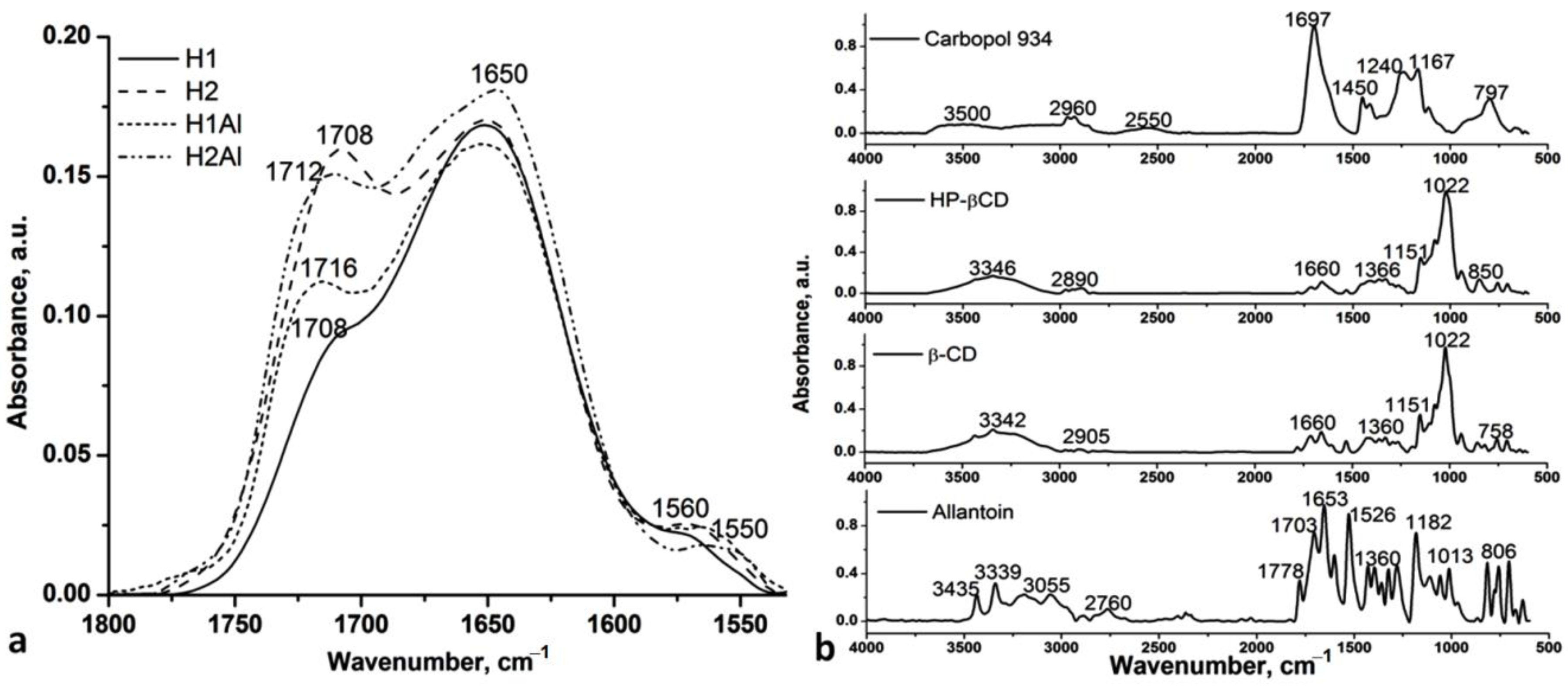
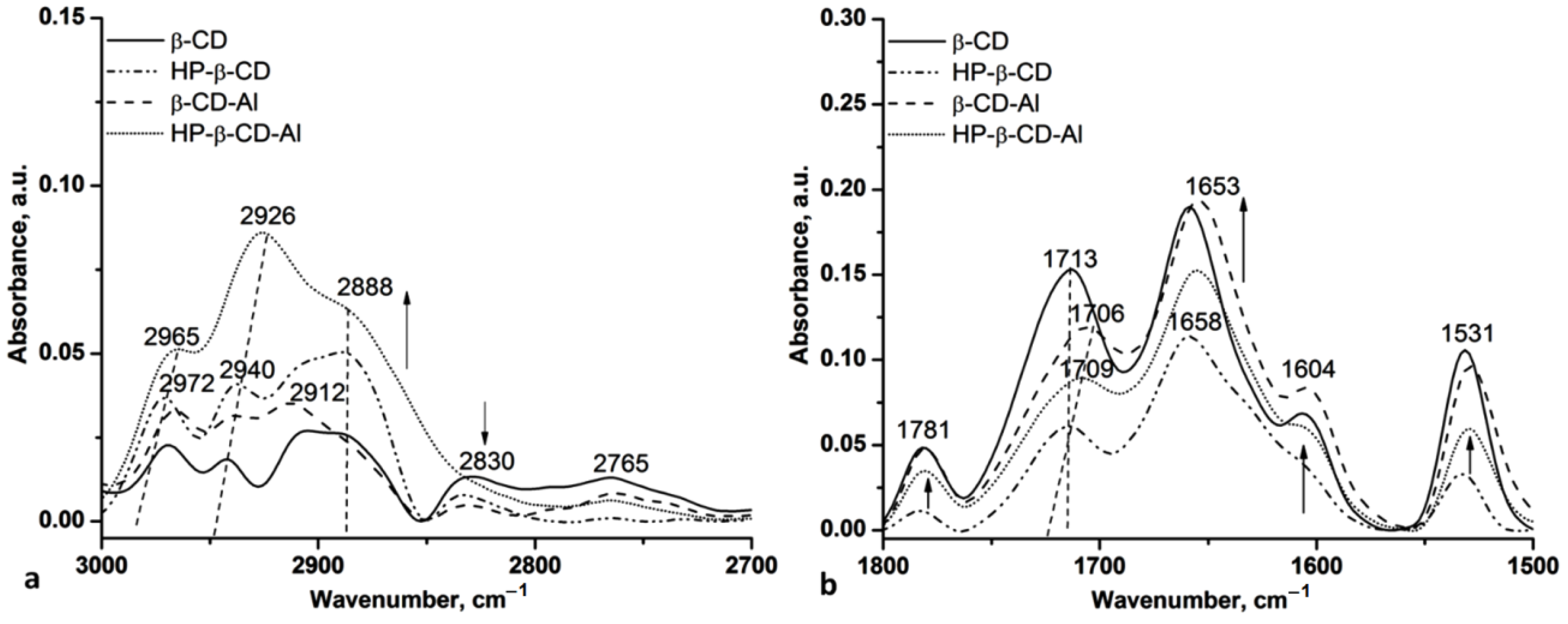
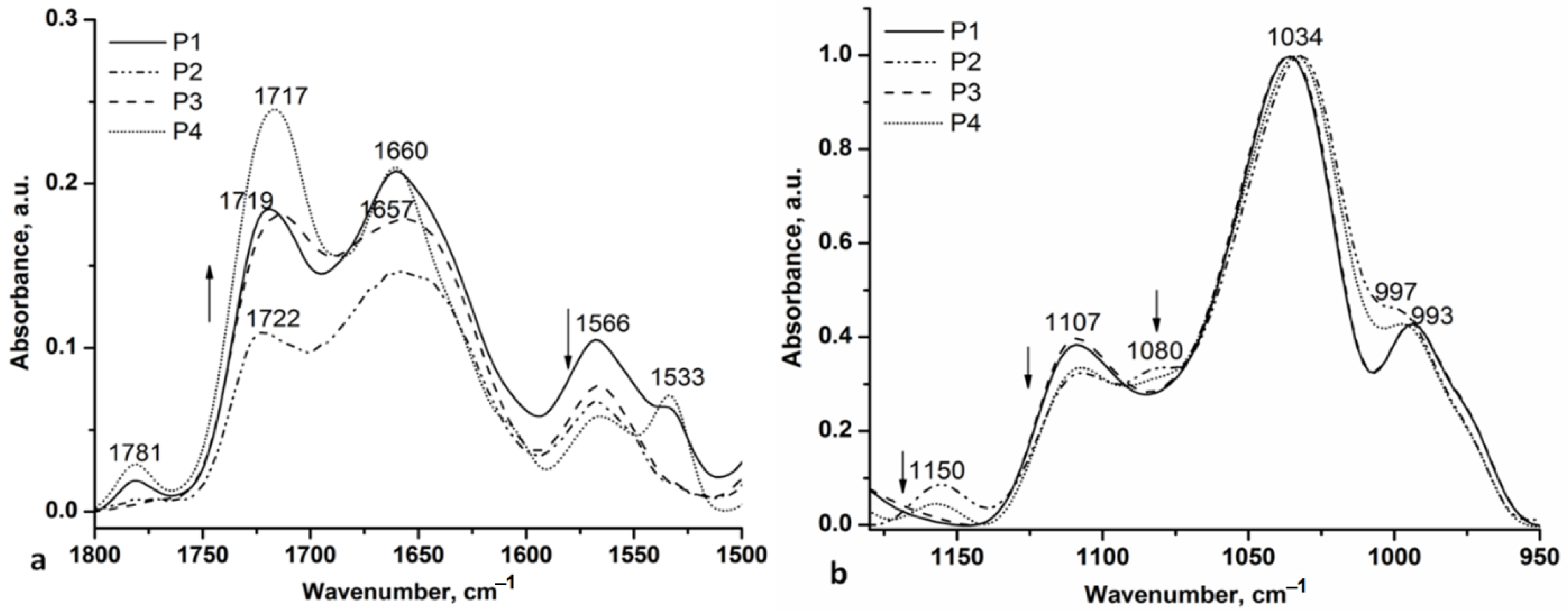

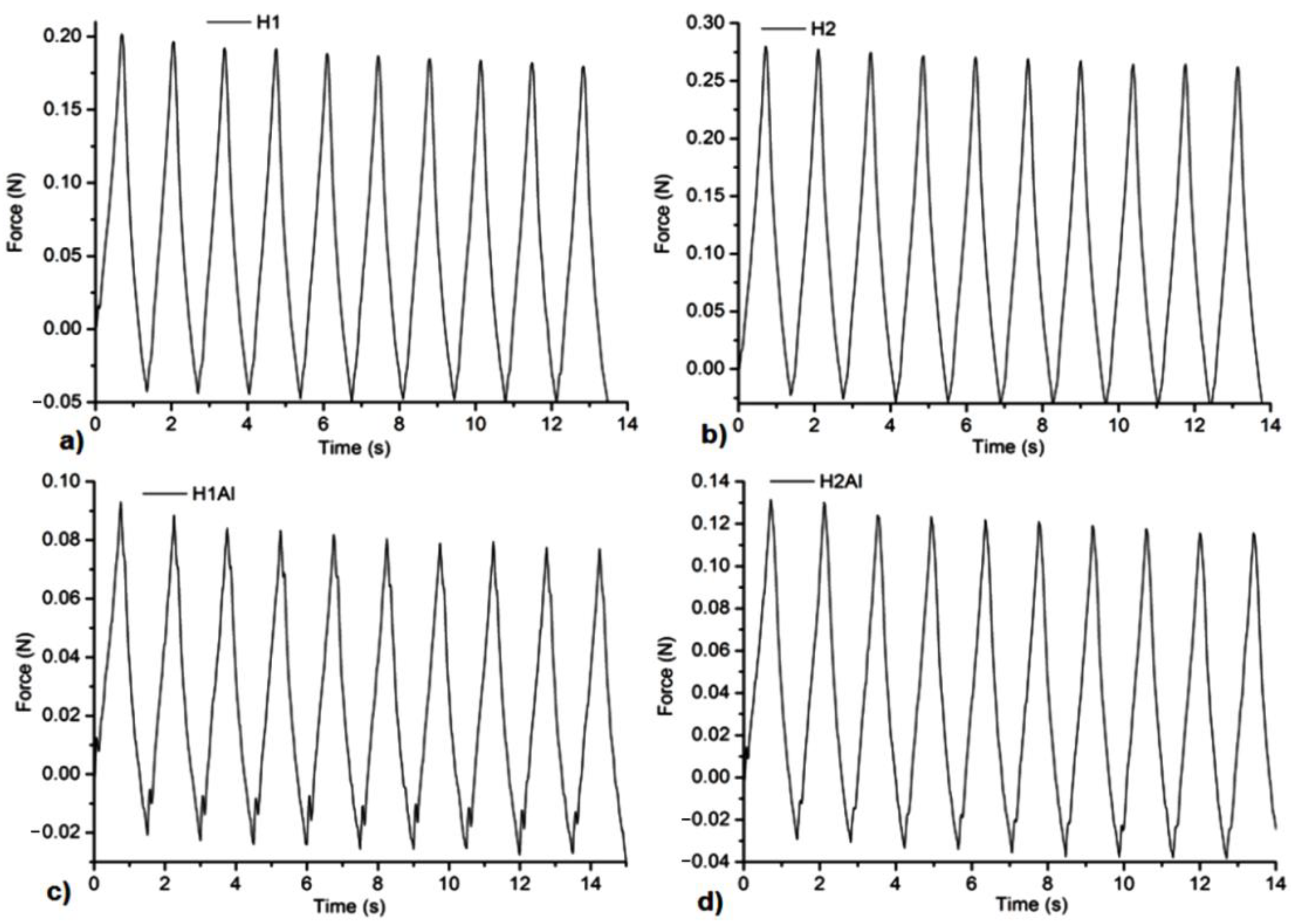
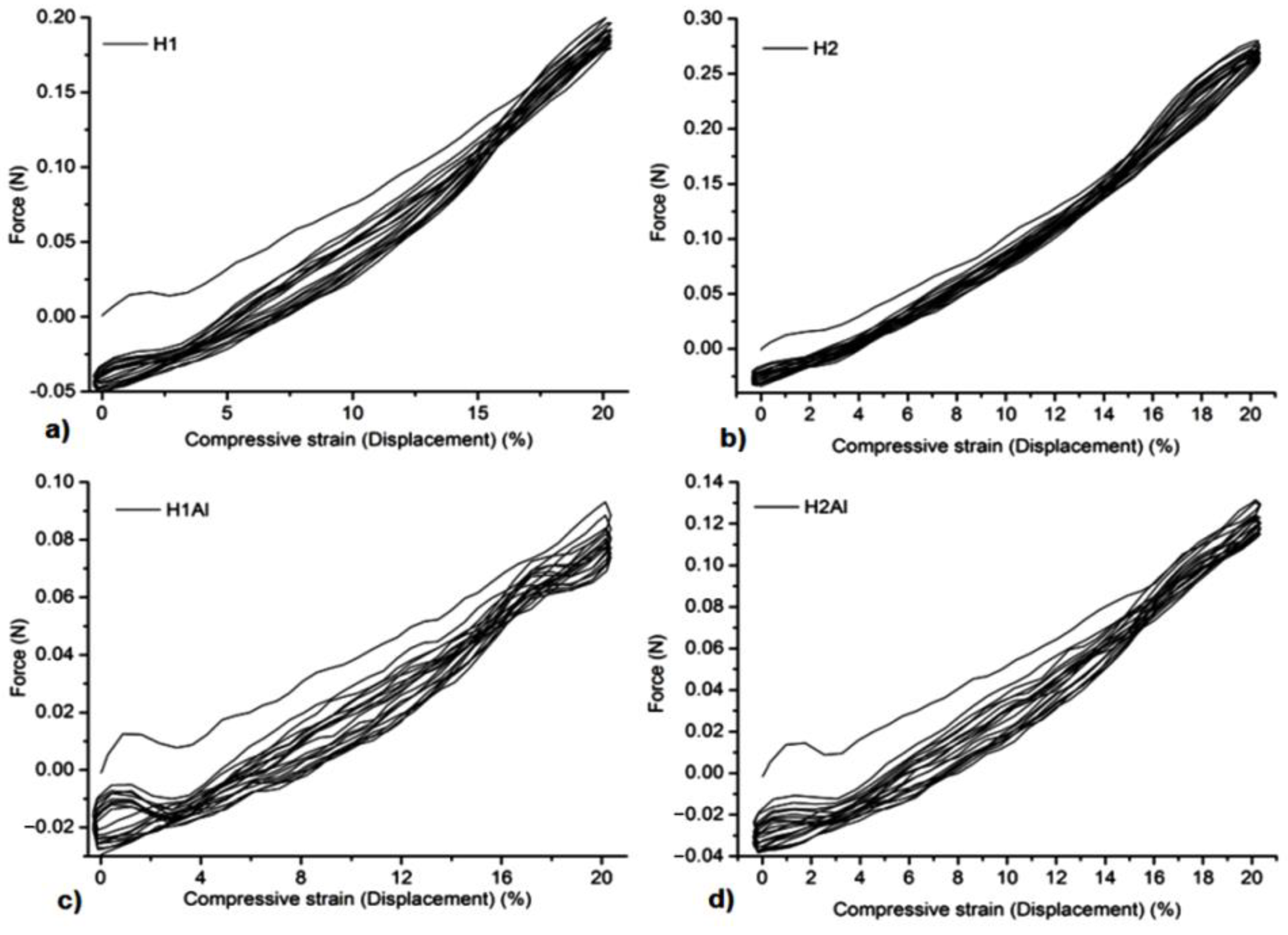

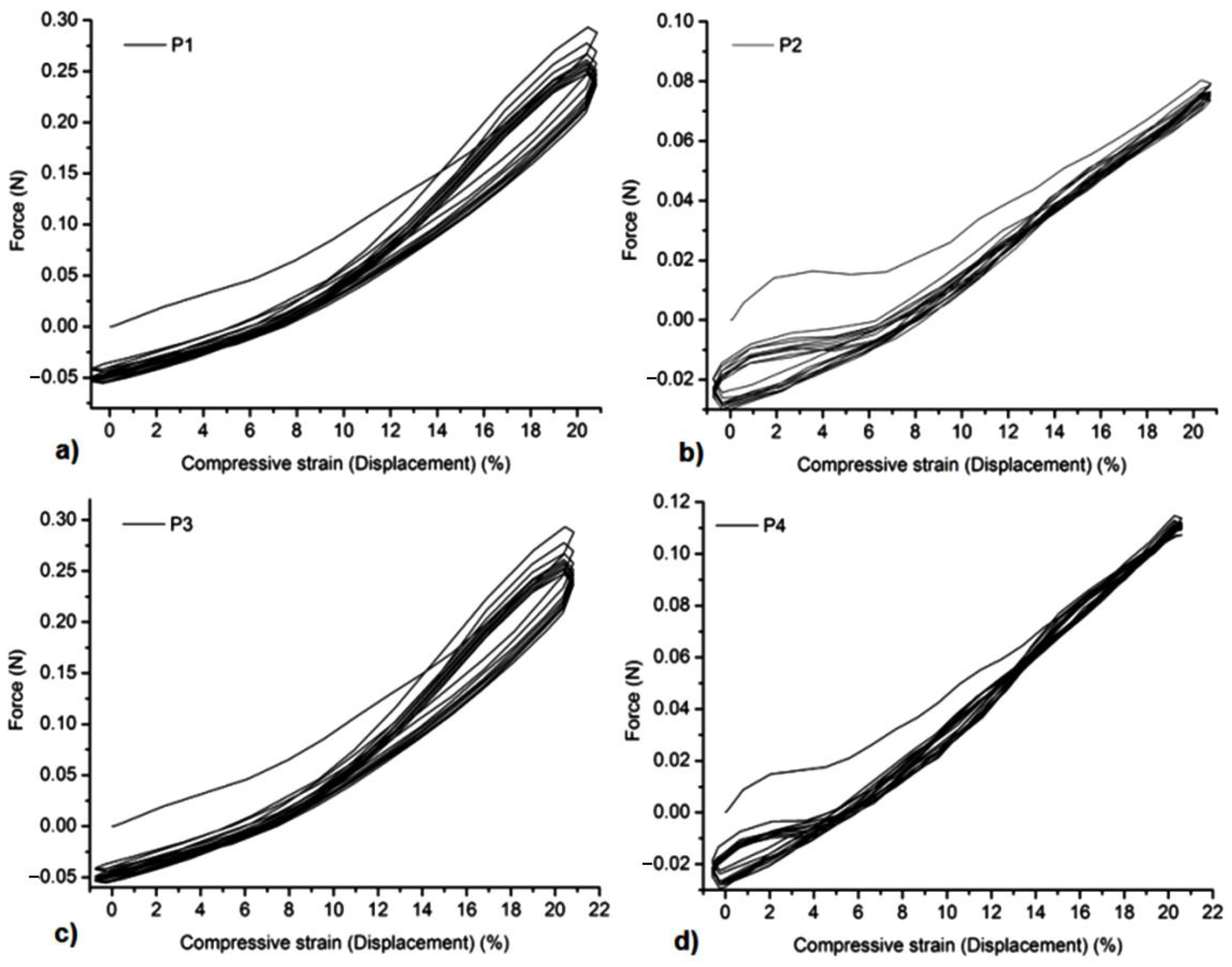
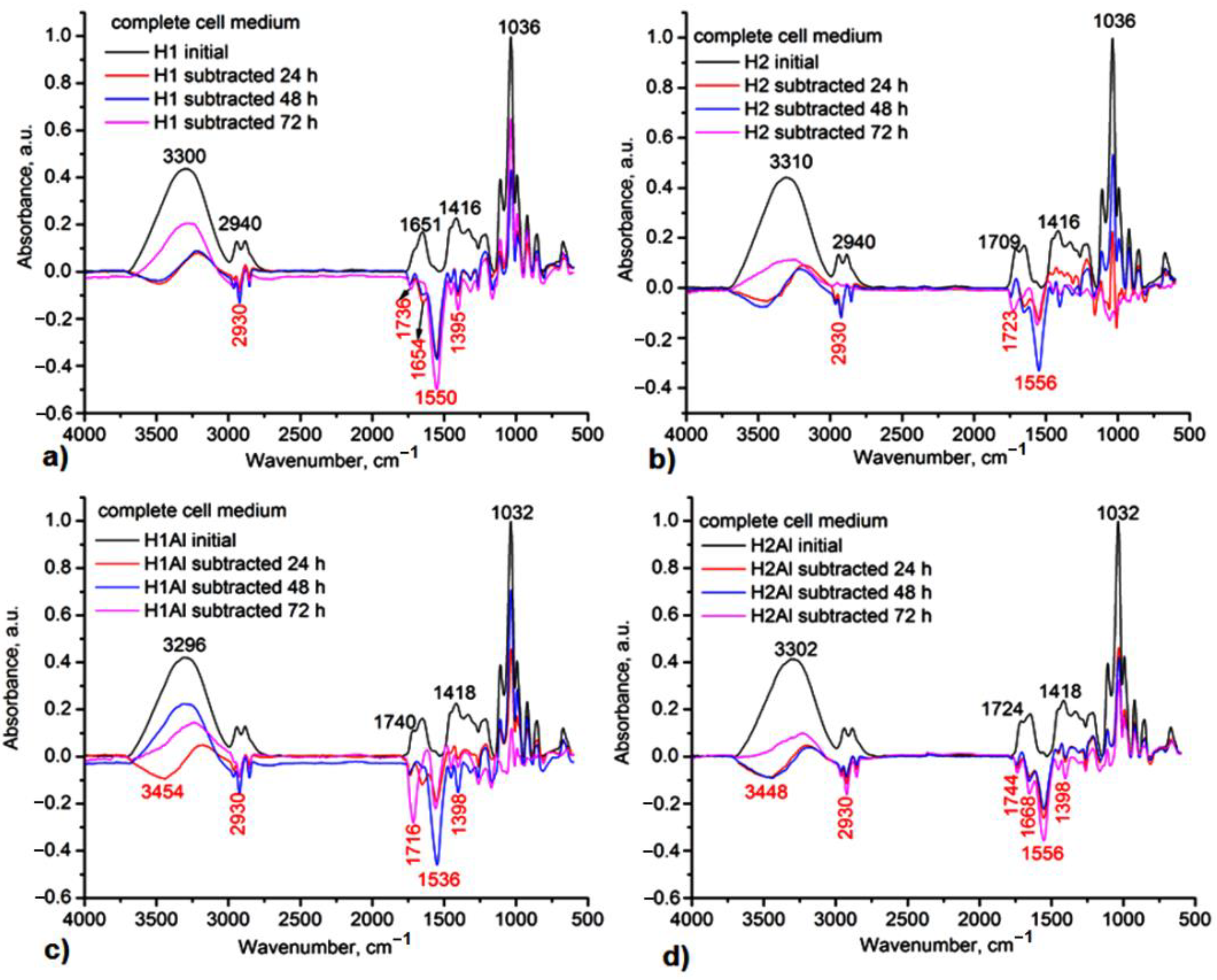

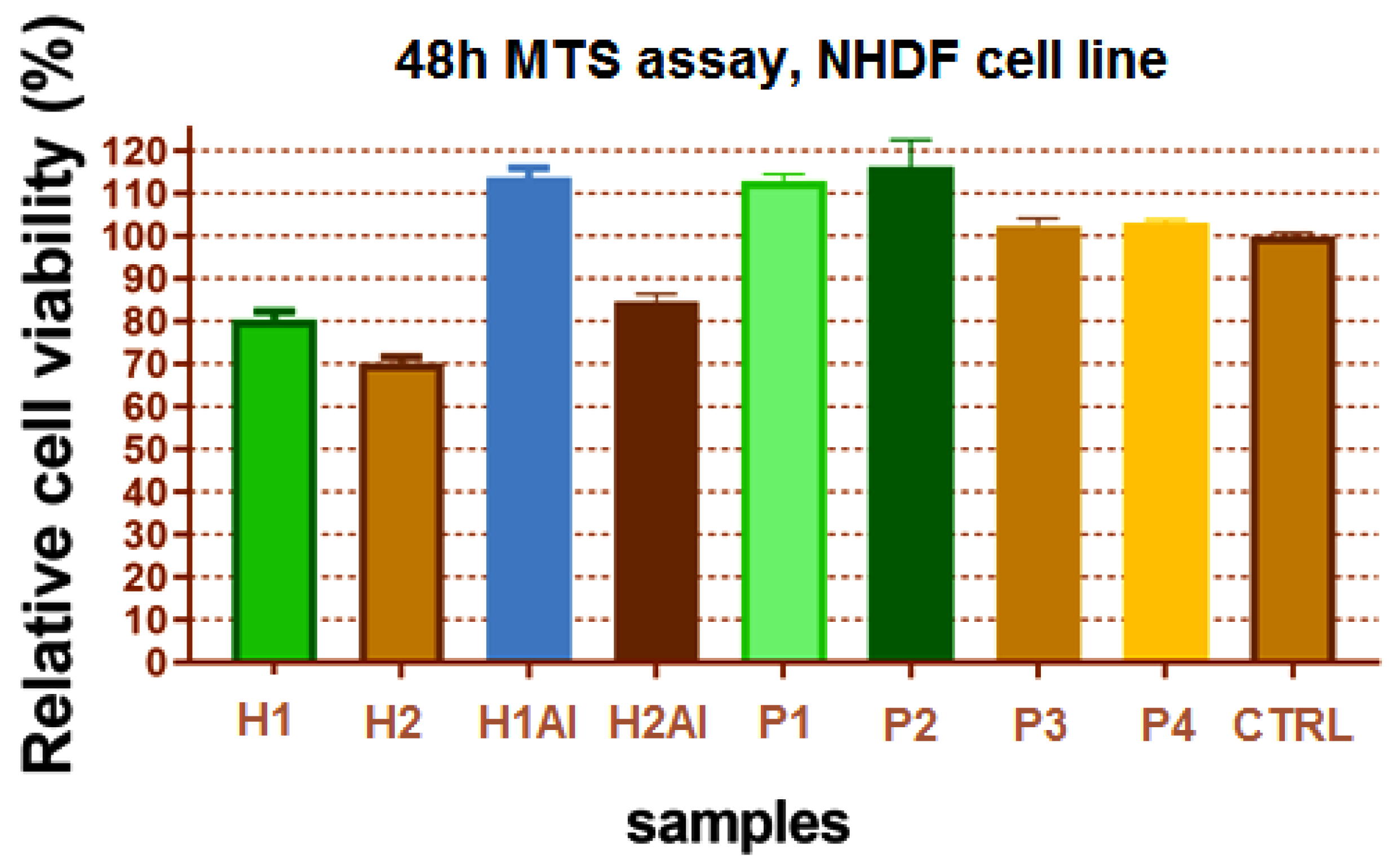

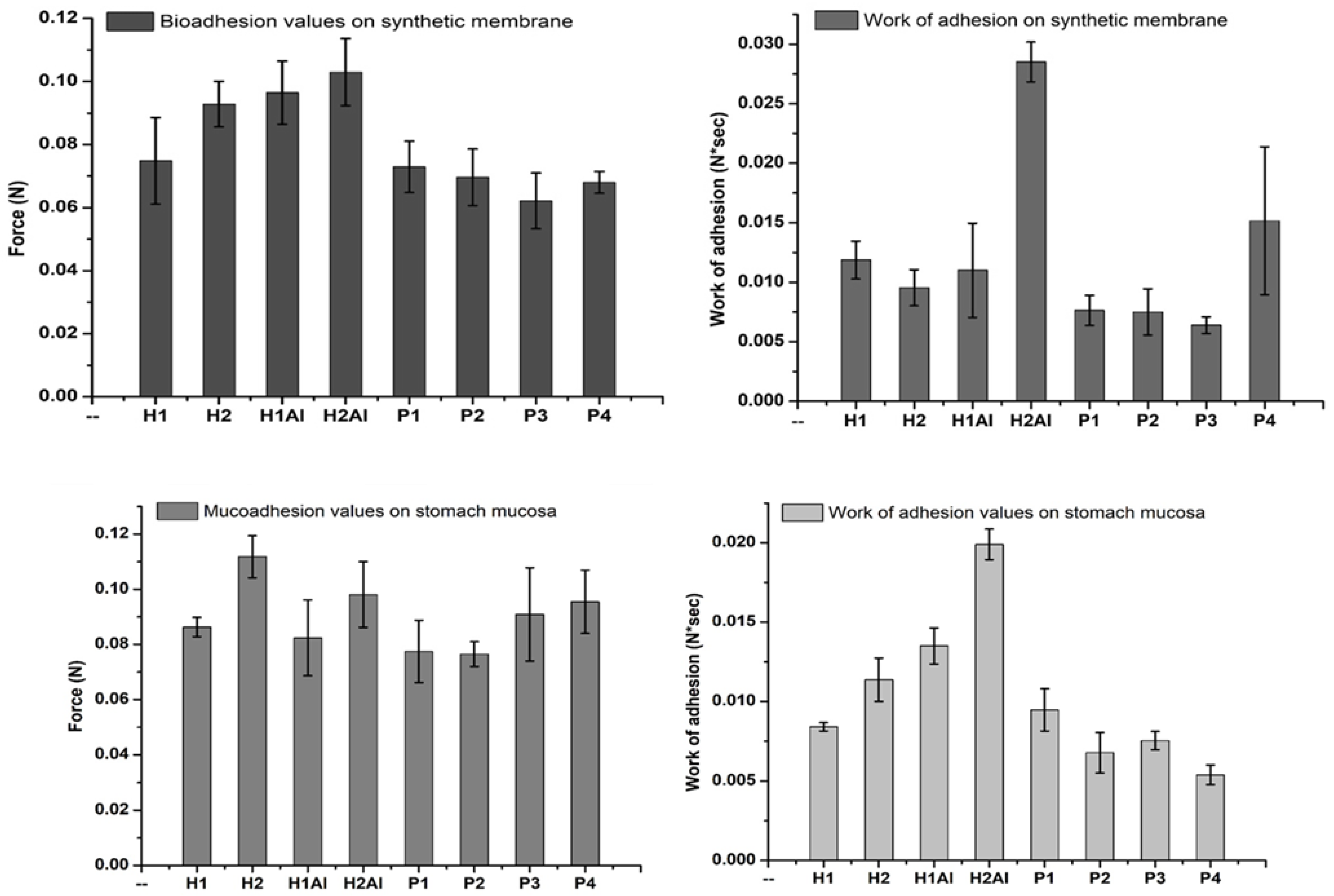

| Sample | Materials | ||||||
|---|---|---|---|---|---|---|---|
| Carbopol 934 | Glycerol | TEA (Drops) | Allantoin % | β-CD | HP-β-CD | Distilled Water q.s. | |
| H1 | 0.5 | 10 | 3 | - | - | - | 100 |
| H2 | 1 | 10 | 5 | - | - | - | 100 |
| H1Al | 0.5 | 10 | 3 | 0.2 | - | - | 100 |
| H2Al | 1 | 10 | 5 | 0.2 | - | - | 100 |
| P1 | 0.5 | 10 | 3 | 0.2 | 1.44 | - | 100 |
| P2 | 0.5 | 10 | 3 | 0.2 | - | 1.75 | 100 |
| P3 | 1 | 10 | 5 | 0.2 | 1.44 | - | 100 |
| P4 | 1 | 10 | 5 | 0.2 | - | 1.75 | 100 |
| Samples | Contact Angle (°) | ||
|---|---|---|---|
| Water | Formamide | Diiodomethane | |
| H1 | 26.60 | 23.47 | 89.03 |
| H2 | 29.94 | 28.09 | 91.25 |
| P1 | 23.12 | 33.16 | 102.23 |
| P2 | 26.49 | 25.82 | 79.88 |
| P3 | 24.35 | 36.81 | 85.75 |
| P4 | 25.75 | 30.32 | 89.62 |
| H1Al | 30.77 | 26.84 | 80.69 |
| H2Al | 26.13 | 31.50 | 99.54 |
| Samples | ΔGw | ||||||
|---|---|---|---|---|---|---|---|
| H1 | 13.13 | 15.81 | 9.61 | 53.08 | 80.14 | 66.21 | −138 |
| H2 | 12.15 | 104.65 | 4.00 | 52.34 | 80.17 | 64.49 | −136 |
| P1 | 7.89 | 126.27 | 9.00 | 63.18 | 88.91 | 71.07 | −140 |
| P2 | 17.56 | 95.83 | 25.00 | 47.88 | 73.17 | 65.44 | −138 |
| P3 | 14.65 | 104.76 | 0.64 | 52.39 | 78.15 | 67.04 | −139 |
| P4 | 12.87 | 107.89 | 9.00 | 53.91 | 80.73 | 66.78 | −138 |
| H1Al | 17.14 | 91.60 | 6.25 | 45.83 | 72.78 | 62.97 | −135 |
| H2Al | 8.84 | 119.47 | 0.04 | 59.74 | 87.11 | 68.58 | −138 |
| Samples | Wa, mN/m | Wa(blood), mN/m | ΔGw, mN/m | , mN/m | , mN/m | , mN/m | Ws/rbc, mN/m | Ws/p, mN/m | |
|---|---|---|---|---|---|---|---|---|---|
| H1 | 138 | 112 | −137.89 | 0.99 | −7.89 | 1.30 | 1.67 | 42 | −143 |
| H2 | 136 | 111 | −135.88 | 0.99 | −9.72 | 1.41 | 1.48 | 110 | −111 |
| P1 | 140 | 115 | −139.76 | 0.97 | −5.86 | 4.11 | 3.99 | 115 | −119 |
| P2 | 138 | 111 | −137.96 | 0.99 | −7.64 | 0.28 | 1.51 | 112 | −100 |
| P3 | 139 | 113 | −139.13 | 0.99 | −6.48 | 0.72 | 1.70 | 113 | −104 |
| P4 | 138 | 112 | −138.37 | 0.99 | −7.23 | 1.21 | 1.79 | 113 | −108 |
| H1Al | 135 | 109 | −135.35 | 0.99 | −10.25 | 0.42 | 1.18 | 108 | −102 |
| H2Al | 138 | 113 | −138.16 | 0.98 | −7.44 | 3.22 | 3.04 | 113 | −118 |
| Sample | K1*, Mt/M∞ < 0.5 | K2*, Mt/M∞ > 0.5 | l (cm) | D1 = K1πl2/16 (cm2/s) | D2 = −K2l2/π2 (cm2/s) |
|---|---|---|---|---|---|
| H1 | 1.89 × 10−5 | −0.00027583 | 0.1 | 3.71 × 10−8 | 2.80 × 10−7 |
| H2 | 1.53 × 10−5 | −0.00022095 | 0.1 | 3.01 × 10−8 | 2.24 × 10−7 |
| H1Al | 1.70 × 10−5 | −0.00021338 | 0.1 | 3.35 × 10−8 | 2.16 × 10−7 |
| H2Al | 1.93 × 10−5 | −0.0002072 | 0.1 | 3.79 × 10−8 | 2.10 × 10−7 |
| P1 | 2.58 × 10−5 | −0.00026206 | 0.1 | 5.06 × 10−8 | 2.66 × 10−7 |
| P2 | 2.31 × 10−5 | −0.00028869 | 0.1 | 4.53 × 10−8 | 2.93 × 10−7 |
| P3 | 2.10 × 10−5 | −0.00027841 | 0.1 | 4.13 × 10−8 | 2.82 × 10−7 |
| P4 | 2.18 × 10−5 | −0.00025906 | 0.1 | 4.29 × 10−8 | 2.63 × 10−7 |
| Sample | S | P(1) × 108 | P(2) × 107 | Uptake Weight at RH 80%, % d.b. |
|---|---|---|---|---|
| H1 | 0.57 | 2.11 | 1.60 | 45.40 |
| H2 | 0.39 | 1.17 | 0.87 | 32.30 |
| H1Al | 0.44 | 1.47 | 0.95 | 36.65 |
| H2Al | 0.59 | 2.24 | 1.24 | 48.71 |
| P1 | 0.54 | 2.73 | 1.44 | 44.40 |
| P2 | 0.41 | 1.86 | 1.20 | 33.61 |
| P3 | 0.36 | 1.49 | 1.02 | 29.5 |
| P4 | 0.52 | 2.23 | 1.37 | 42.98 |
| Samples | Diameter of Inhibition Zones (mm) | |||
|---|---|---|---|---|
| S. aureus ATCC25923 | E. coli ATCC 25922 | P. aeruginosa ATCC27853 | C. albicans ATCC10231 | |
| H1Al | 12.1 ± 0.05 | 0 | 0 | 11.5 ± 0.50 |
| H2Al | 13.0 ± 0.00 | 0 | 0 | 12.5 ± 0.50 |
| P1 | 11.0 ± 0.00 | 0 | 0 | 0 |
| P2 | 17.0 ± 0.00 | 0 | 0 | 0 |
| P3 | 16.3 ± 0.57 | 0 | 0 | 16.3 ± 0.57 |
| P4 | 16.0 ± 0.00 | 0 | 0 | 19.0 ± 0.00 |
| Ciprofloxacin (5 µg/disc) | 27.7 ± 0.06 | 32.0 ± 0.00 | 32.0 ± 0.00 | NT* |
| Fluconazol (25 µg/disc) | NT* | NT* | NT* | 30.0 ± 0.00 |
| Voriconazol (1 µg/disc) | NT* | NT* | NT* | 29.5 ± 0.50 |
Publisher’s Note: MDPI stays neutral with regard to jurisdictional claims in published maps and institutional affiliations. |
© 2022 by the authors. Licensee MDPI, Basel, Switzerland. This article is an open access article distributed under the terms and conditions of the Creative Commons Attribution (CC BY) license (https://creativecommons.org/licenses/by/4.0/).
Share and Cite
Filip, D.; Macocinschi, D.; Zaltariov, M.-F.; Gafitanu, C.A.; Tuchilus, C.G.; Bele, A.; Ciubotaru, B.-I.; Stoleru, E.; Bargan, A. Mucoadhesive and Antimicrobial Allantoin/β Cyclodextrins-Loaded Carbopol Gels as Scaffolds for Regenerative Medicine. Gels 2022, 8, 416. https://doi.org/10.3390/gels8070416
Filip D, Macocinschi D, Zaltariov M-F, Gafitanu CA, Tuchilus CG, Bele A, Ciubotaru B-I, Stoleru E, Bargan A. Mucoadhesive and Antimicrobial Allantoin/β Cyclodextrins-Loaded Carbopol Gels as Scaffolds for Regenerative Medicine. Gels. 2022; 8(7):416. https://doi.org/10.3390/gels8070416
Chicago/Turabian StyleFilip, Daniela, Doina Macocinschi, Mirela-Fernanda Zaltariov, Carmen Anatolia Gafitanu, Cristina Gabriela Tuchilus, Adrian Bele, Bianca-Iulia Ciubotaru, Elena Stoleru, and Alexandra Bargan. 2022. "Mucoadhesive and Antimicrobial Allantoin/β Cyclodextrins-Loaded Carbopol Gels as Scaffolds for Regenerative Medicine" Gels 8, no. 7: 416. https://doi.org/10.3390/gels8070416
APA StyleFilip, D., Macocinschi, D., Zaltariov, M.-F., Gafitanu, C. A., Tuchilus, C. G., Bele, A., Ciubotaru, B.-I., Stoleru, E., & Bargan, A. (2022). Mucoadhesive and Antimicrobial Allantoin/β Cyclodextrins-Loaded Carbopol Gels as Scaffolds for Regenerative Medicine. Gels, 8(7), 416. https://doi.org/10.3390/gels8070416








